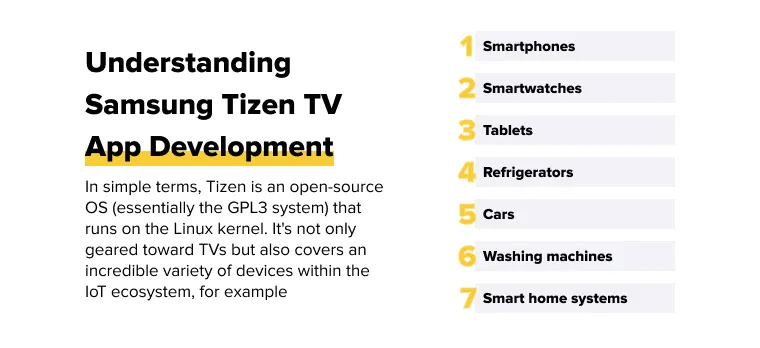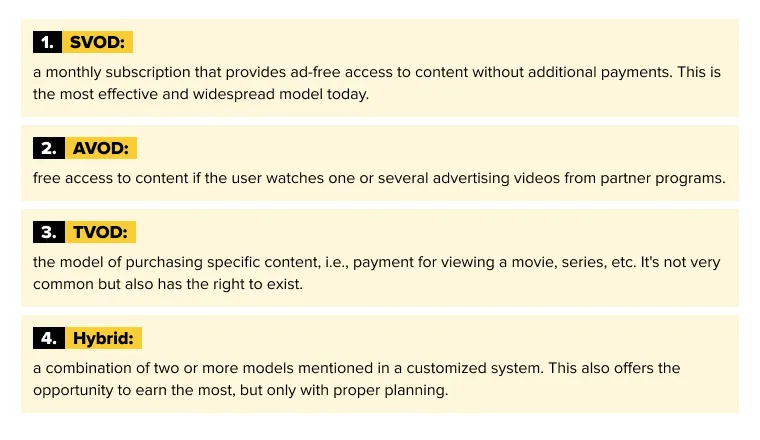Do you know that the South Korean tech brand Samsung dominates the TV market? According to Statista, its share in the global market was 19.6% in 2022, which is 8% higher than its closest competitors.
Of course, their product lineup offers various options with different prices and technical features. However, today we're only interested in a specific subset of devices – Smart TVs that run on the Tizen operating system.
If in 2020, the market share of this OS was 12.7%, now, according to different data, this figure has changed and reached 20-22%.
As you can see, the industry's development is positive. This means that in 2023, it's possible to launch the TV app development and plan the application's monetization.
The experts at Lampa Software have prepared material that will inform you about the following:
Details of the Tizen app development process.
The importance of planning audience outreach.
Possibilities and advantages of customization.
Coding specifics for the mentioned operating system.
Types of monetization and marketing for Tizen apps.
And let's start with the basics, namely – the system's characteristics for Smart TV.

Both Tizen Wearable and Tizen OS for other devices offer the flexibility to be personalized according to the target audience's needs. Moreover, anyone can implement a Tizen TV app, integrating it as an OEM component or deploying it separately.
Tizen OS: Benefits and Features
When it comes to Linux-based OS, the possibilities for creating digital products are virtually limitless. For instance, you can have OTT platforms, streaming apps, or video content servers integrated within a single system.
You can even create a mobile app and quickly adapt it to work on Tizen or vice versa. The platform's potential is truly unrestricted.
Diversity in the Device Lineup
One challenge (not exclusive to Tizen but all TV platforms) is the diversity of models available, such as different screen sizes and technical specifications like processors, RAM, display technologies, OS versions, etc. Therefore, when developing a Tizen product, it's essential to consider the specifications of all potential devices where the app might be installed.
However, there are solutions to avoid some of the issues during Samsung Smart TV app development, but we'll discuss that later.
Key Considerations for Samsung Tizen TV App Development
Let's provide a brief overview of the platform concerning app development and highlight the key advantages a new app can bring to the system.
So, if you're planning to launch your own Tizen TV app development, familiarize yourself with the following information. It will help you properly assess the potential of your IT solution and choose an effective strategy for its creation.
Web-native languages
While you can use the Smart View SDK to launch your live streaming service, such an approach significantly limits the possibilities and creative space. It's recommended to implement the project using Tizen Studio (for Windows, MacOS, or Ubuntu) or other frameworks from the Web-native languages family (HTML5, JavaScript, PHP, etc.).
Regardless of the approach, focus not only on development but also on testing your hypothetical streaming platform and adapting the IT solution for a wide range of Tizen TV models.
Expanding Smart TV Use Cases
Samsung TV App development services allows for significantly enhancing the device's functionality and capabilities. For instance, you can implement a real-time multilingual translator with integrated broadcasting through the built-in interface.
Another example is a video streaming service with demo access and the ability to diversify content within a single transmission using a server-side randomizer.
Steps in Samsung Tizen TV App Development
In brief, the app development of Samsung Smart TV follows a chain of sequential steps geared toward maximizing monetization opportunities.
Don't believe it? Let's walk through a typical scenario of developing a digital TV solution.
Idea and Concept
First and foremost, you need to analyze the niche and choose your target audience for the product. Then, formulate the concept of the IT solution, its functionality, and unique selling points (UTP).
This will help create a foundation that aligns with various technical implementation variations, forming a business plan to determine the product's potential.
However, don't rush into development until you're confident in selecting the most profitable option with minimal risks.
Development
The actual app development for TVs isn't problematic. However, it has certain peculiarities worth considering, such as:

If you specialize in development (tech startups or companies), explore open-source platforms before starting the process.
If you're an entrepreneur with a unique idea, seek help from experts like Lampa Software.
This way, you can focus on your operations while your product takes shape.
Testing
If you think that creating the program code allows for an immediate production launch, you're mistaken. Comprehensive testing of the IT solution is crucial, as it saves resources, budget, and nerves.
Considering the potential range of devices, there are several testing approaches:

The latter method is the most effective as it automates checks and provides the most truthful results. This way, you can test both input methods (voice, remote control, etc.) and the program's performance, design adaptability, connection stability, etc.
Deployment and Support
The final stage of Samsung TV app development involves placing the IT solution in the relevant store and providing ongoing software support.
For the former, you'll need a verified developer profile, such as the one from Lampa Software, which requires some time for approval and moderation.
For the latter, you need a reliable partner to handle tasks related to servicing the digital solution, scalability, testing, etc. For example, Lampa Software.
With these components in place, the viability of your IT product is guaranteed. However, it's crucial to properly advertise and monetize it.
Monetization and Distribution of Samsung Tizen TV Apps
We all understand that monetization is the main idea behind any platform's software development. And TV is almost a perfect fit for this.
Just imagine that Netflix made almost $32 billion in 2022. Such a streaming multiplatform can be realized with your concept. Have you assessed the prospects?
However, to be more pragmatic, it's unlikely that you can compete with key players in the market right away. But in the long run, it's entirely possible, especially with a well-formed business plan that includes multiple monetization models and a profound marketing strategy.
Monetization Models
Conditional monetization of IT solutions for Smart TVs can be divided into four categories:

As you can see, the choice of monetization methods is quite broad. All of them are effective, albeit only for certain digital solutions, and with a well-thought-out marketing strategy.
Marketing the Software
There's no one-size-fits-all and effective marketing methodology. Lead generation depends on how well you formulate your UTP (Unique Selling Proposition) and communicate its value to the target audience (TA).
When choosing marketing channels, a comprehensive approach is necessary, i.e., promoting the IT solution through all possible means.
As for when to start the advertising campaign, there's no definitive tactic. The main thing is to launch it so that you have some leads by the time of the release but not make them wait too long for the software's publication.
Best Practices and Tips for Samsung Tizen TV App Development
We could have ended the content here, but Samsung TV development has a few nuances worth mentioning. Specifically, recommendations to improve the product and its monetization and reduce costs in its realization.
Defining the TA and Product Value
You can't please everyone at once; that's an axiom passed down through generations. So, focus on a specific niche, such as millennials. Identify their interests and passions, and adapt your idea to their needs.
Starting with this is enough, and once your product is profitable and you are in the black, you can scale up. That means expanding your reach and generating leads from other user categories.
Integration of Innovations
Augmented reality headsets, equipment for simulating physical sensations.. It sounds cool, but it's expensive, time-consuming, and not very profitable.
Innovations are usually very niche, like headsets that cost around $800 or more and have limited demand. Pursuing such technical solutions will only invest money in development without receiving profits from these innovations, even in the long run.
This doesn't mean you should abandon progressive solutions. Just choose those that the majority of your potential TA will use.
Adaptation and Cost Reduction
When developing a digital product, focus on a model range no older than four previous generations. This will reduce costs for adapting the tech stack to the equipment's specifics and OS versions. As for screen diagonals, there's no need to compromise, as every product has its buyer, your potential customer.
Future Trends and Innovations in Samsung Tizen TV App Development
In the coming decade, we'll witness significant progress in AI research and its integration into various products, including Smart TVs. This will expand the functionality of these solutions and enhance user interactions. Adding VR technologies to the mix, which will soon immerse users into digital universes, creates a whole new realm of entertainment possibilities.
And this isn't a distant future prediction; it's what we need to prepare for now as we lay the foundation for IT solutions capable of bringing these and other concepts to life.
Conclusion
Surprisingly, the Smart TV app market, including Tizen OS, still has room for new ideas even in 2023. While many apps exist, most fail to meet industry standards and user needs to the fullest.
That's why 2023 is the perfect time to launch your project into the smart TV market. And the ideal partner to help you realize your vision is the Lampa Software team.
Seize this opportunity to make a powerful debut in the segment. Entrust your project to Lampa Software and prepare for great profits from Smart TV apps.